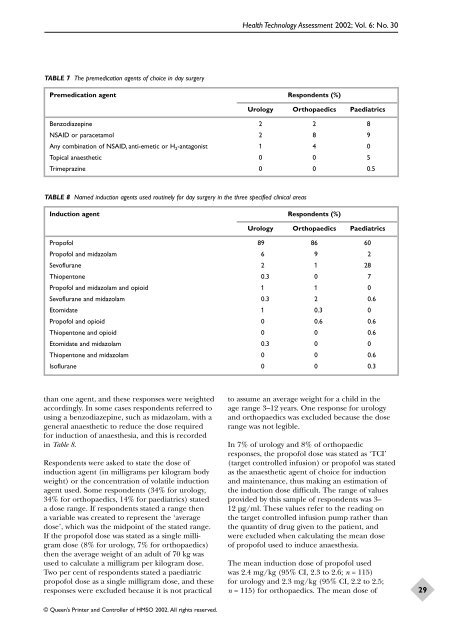Aanesthetic Agents for Day Surgery - NIHR Health Technology ...
Aanesthetic Agents for Day Surgery - NIHR Health Technology ...
Aanesthetic Agents for Day Surgery - NIHR Health Technology ...
You also want an ePaper? Increase the reach of your titles
YUMPU automatically turns print PDFs into web optimized ePapers that Google loves.
TABLE 7 The premedication agents of choice in day surgery<br />
than one agent, and these responses were weighted<br />
accordingly. In some cases respondents referred to<br />
using a benzodiazepine, such as midazolam, with a<br />
general anaesthetic to reduce the dose required<br />
<strong>for</strong> induction of anaesthesia, and this is recorded<br />
in Table 8.<br />
Respondents were asked to state the dose of<br />
induction agent (in milligrams per kilogram body<br />
weight) or the concentration of volatile induction<br />
agent used. Some respondents (34% <strong>for</strong> urology,<br />
34% <strong>for</strong> orthopaedics, 14% <strong>for</strong> paediatrics) stated<br />
a dose range. If respondents stated a range then<br />
a variable was created to represent the ‘average<br />
dose’, which was the midpoint of the stated range.<br />
If the propofol dose was stated as a single milligram<br />
dose (8% <strong>for</strong> urology, 7% <strong>for</strong> orthopaedics)<br />
then the average weight of an adult of 70 kg was<br />
used to calculate a milligram per kilogram dose.<br />
Two per cent of respondents stated a paediatric<br />
propofol dose as a single milligram dose, and these<br />
responses were excluded because it is not practical<br />
© Queen’s Printer and Controller of HMSO 2002. All rights reserved.<br />
<strong>Health</strong> <strong>Technology</strong> Assessment 2002; Vol. 6: No. 30<br />
Premedication agent Respondents (%)<br />
Urology Orthopaedics Paediatrics<br />
Benzodiazepine 2 2 8<br />
NSAID or paracetamol 2 8 9<br />
Any combination of NSAID, anti-emetic or H2-antagonist 1 4 0<br />
Topical anaesthetic 0 0 5<br />
Trimeprazine 0 0 0.5<br />
TABLE 8 Named induction agents used routinely <strong>for</strong> day surgery in the three specified clinical areas<br />
Induction agent Respondents (%)<br />
Urology Orthopaedics Paediatrics<br />
Propofol 89 86 60<br />
Propofol and midazolam 6 9 2<br />
Sevoflurane 2 1 28<br />
Thiopentone 0.3 0 7<br />
Propofol and midazolam and opioid 1 1 0<br />
Sevoflurane and midazolam 0.3 2 0.6<br />
Etomidate 1 0.3 0<br />
Propofol and opioid 0 0.6 0.6<br />
Thiopentone and opioid 0 0 0.6<br />
Etomidate and midazolam 0.3 0 0<br />
Thiopentone and midazolam 0 0 0.6<br />
Isoflurane 0 0 0.3<br />
to assume an average weight <strong>for</strong> a child in the<br />
age range 3–12 years. One response <strong>for</strong> urology<br />
and orthopaedics was excluded because the dose<br />
range was not legible.<br />
In 7% of urology and 8% of orthopaedic<br />
responses, the propofol dose was stated as ‘TCI’<br />
(target controlled infusion) or propofol was stated<br />
as the anaesthetic agent of choice <strong>for</strong> induction<br />
and maintenance, thus making an estimation of<br />
the induction dose difficult. The range of values<br />
provided by this sample of respondents was 3–<br />
12 µg/ml. These values refer to the reading on<br />
the target controlled infusion pump rather than<br />
the quantity of drug given to the patient, and<br />
were excluded when calculating the mean dose<br />
of propofol used to induce anaesthesia.<br />
The mean induction dose of propofol used<br />
was 2.4 mg/kg (95% CI, 2.3 to 2.6; n = 115)<br />
<strong>for</strong> urology and 2.3 mg/kg (95% CI, 2.2 to 2.5;<br />
n = 115) <strong>for</strong> orthopaedics. The mean dose of<br />
29
















